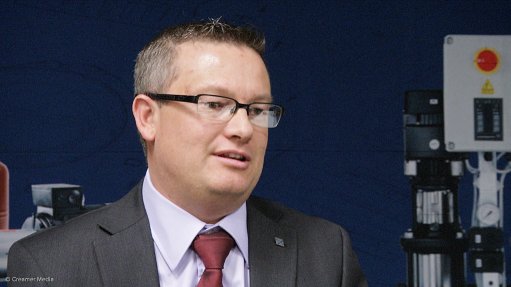
Pump manufacturer Grundfos’s sub-Saharan Africa headquarters and factory have become South Africa’s first industrial facility to receive a 5-star Green Star rating from the Green Building Council of South Africa (GBCSA). The property, in Germiston, which falls under the Ekurhuleni municipal area, is owned by property development group Growthpoint Properties.
“The 10 000 m2 building has incorporated timed energy-saving lights, solar panels, a rainwater harvesting system and waterless urinals. “Construction of the building cost R80-million and 50% of the building’s energy and water come from alternative sources,” said Grundfos South Africa MD Jonathan Hamp-Adams during a tour of the building, in Johannesburg, last week.
He stated that the rating was official acknowledgement of the firm’s green ethos, demonstrated by the integrated industrial and office component of its sub-Saharan Africa headquarters development in Johannesburg.
Hamp-Adams explained that Grundfos, in conjunction with Growthpoint, demolished its existing facility and ensured that the rubble and waste material were removed in a responsible manner so that much of it could be recycled into the new building.
“A building management system was installed to electronically monitor and control electricity, fuel and water, and simultaneously manage the carbon dioxide levels in the building and around the site,” he said, adding that the new materials in the building complied with GBCSA specifications.
He noted that the building also used energy-saving technologies for lighting, ventilation and water harvesting, with areas having been demarcated for the recycling of paper, cardboard, plastic and metals.
Engineering News reported last month that the most notable sustainable feature of the Grundfos development, including the offices and warehouse, was its ability to be independent from municipal water supply for as much as 75% of the year.
The project’s rainwater harvesting system incorporates Grundfos’s own customised plant to purify harvested rainwater to water fit for drinking, with the domestic water supply of the building having been designed to use three different sources of rainwater and borehole and municipal water.
“With an extensive rainwater catchment area, an oversized attenuation tank and a purification plant, the quantity of rainwater supplied to the building exceeds the demand for municipal water, except in the dry months of July and August,” said technical services provider Aurecon, the environmentally sustainable design consultant, which provided civil, structural and mechanical design and execution services.
The rainwater harvesting system was designed to use borehole water, with the building using municipal water only when rainwater and borehole water have been exhausted.
“With expected zero demand for municipal water supply during the period of October to May, the design of the rainwater harvesting system – incorporating the Grundfos water-treatment technology to produce drinking-quality water – contributes considerably to the alleviation of pressure being put on the bulk potable-water supply network,” Aurecon pointed out.
Further, the west façade comprises vertical shading louvres, consisting of Grundfos solar panels and mesh, which absorb sun energy from the west side to generate enough electricity to run all pumps in the rainwater purification plant. Daylight glare control is achieved through vertical fixed shading elements in the façade, which incorporates photovoltaic panels and in-house blinds in the occupied areas.
Wind turbines on the roof also generate elec-tricity.
Fresh air provided in the building exceeds the minimum regulatory SANS 10400-O requirements, and energy consumption is improved using variable-speed drives for mechanical equipment, energy efficient lighting and heat pumps that supply hot water for the kitchen and gymnasium. All energy consumers above 100 kVA were also submetered and monitored.